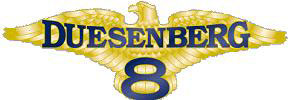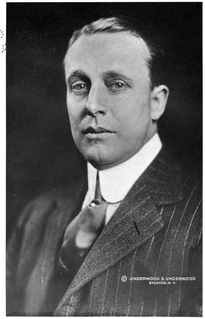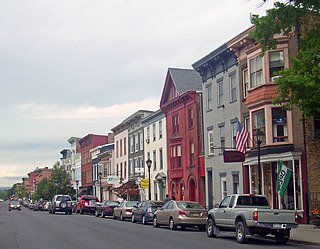
The Winton Motor Carriage Company was a pioneer United States automobile manufacturer based in Cleveland, Ohio. Winton was one of the first American companies to sell a motor car.

Packard was an American luxury automobile marque built by the Packard Motor Car Company of Detroit, Michigan, United States. The first Packard automobiles were produced in 1899, and the last Detroit-built Packard in 1956, when they built the Packard Predictor, their last concept car.

Studebaker was an American automobile manufacturer based in South Bend, Indiana. Founded in 1852 and incorporated in 1868 as the Studebaker Brothers Manufacturing Company, the firm was originally a producer of wagons for farmers, miners, and the military.

Nash Motors Company was an American automobile manufacturer based in Kenosha, Wisconsin, in the United States from 1916 to 1937. From 1937 to 1954, Nash Motors was the automotive division of the Nash-Kelvinator Corporation. Nash production continued from 1954 to 1957 after the creation of American Motors Corporation.

The Hudson Motor Car Company made Hudson and other brand automobiles in Detroit, Michigan, from 1909 to 1954. In 1954, Hudson merged with Nash-Kelvinator to form American Motors Corporation (AMC). The Hudson name was continued through the 1957 model year, after which it was discontinued.

Duesenberg Motors Company was an American manufacturer of race cars and luxury automobiles. It was founded by brothers August and Frederick Duesenberg in 1913 in Saint Paul, Minnesota, where they built engines and race cars. The brothers moved their operations to Elizabeth, New Jersey in 1916 to manufacture engines for World War I. In 1919, when their government contracts were cancelled, they moved to Indianapolis, Indiana, home of the Indianapolis Motor Speedway, and established the Duesenberg Automobile and Motors Company, Inc. (Delaware). In late 1926, E.L. Cord added Duesenberg to his Auburn Automobile Company. With the market for expensive luxury cars severely undercut by the Depression, Duesenberg folded in 1937.

The Packard Clipper is an automobile which was built by the Packard Motor Car Company for models years 1941–1942, 1946–1947 and 1953–1957. For 1956 only, Clipper was classified as a stand-alone marque. The Clipper was introduced in April, 1941, as a mid-model year entry. It was available only as a four-door sedan. The Clipper name was reintroduced in 1953, for the automaker's lowest-priced lineup. By 1955, the Clipper models were seen as diluting Packard's marketing as a luxury automobile marque. It was named for a type of sailing ship, called a clipper.

Fisher Body was an automobile coachbuilder founded by the Fisher brothers in 1908 in Detroit, Michigan; it had been a division of General Motors for many years, but in 1984 was dissolved to form other General Motors divisions. Fisher & Company continues to use the name. The name and its iconic "Body by Fisher" logo were well known to the public, as General Motors vehicles displayed a "Body by Fisher" emblem on their door sill plates until the mid-1990s.

The Henney Kilowatt was an electric car introduced in the United States for the 1959 model year. The car used some body parts as made for the Renault Dauphine. An improved model was introduced in 1960 with a top speed of 60 miles an hour and a range of 60 miles. Only 47 cars were sold over the two model years, mostly to electrical utility companies. Only a few still exist.

The Nash 600 is an automobile that was manufactured by the Nash-Kelvinator Corporation of Kenosha, Wisconsin for the 1941 through 1949 model years, after which the car was renamed the Nash Statesman. The Nash 600 was positioned in the low-priced market segment. The '600' name comes from the car's ability to go 600 miles (970 km) on one tank of gasoline. Introduced for the 1941 model year, the Nash 600 became the first mass-produced unibody constructed car built in the United States.
Dietrich Inc. was an American coachbuilder founded in 1925 by Raymond H. Dietrich ( 1894–1980), co-founder of LeBaron Incorporated in New York City. He was a close friend to Edsel Ford who supported him by talking the owner of the J W Murray Manufacturing Co into partly financing the venture. Murray was itself a vendor of standard bodies to the Ford Motor Company, and hoped for an in-house source for designing and building custom bodies for luxury cars. Dietrich himself held 50% of the stock.

The Packard 180 was introduced for the 1940 model year by the Packard Motor Car Company to replace the discontinued Packard Twin Six as their top-of-the-line luxury model. The correct name of the model was Custom Super Eight One-Eighty. The car was derived from the Packard Super Eight One-Sixty with which it shared the complete running gear including the in-line eight-cylinder, 356-cubic-inch (5,830 cc) engine that developed 160 horsepower. It was advertised as the most powerful eight-cylinder engine offered by any automobile manufacturer in 1940.. It replaced the Packard Eight, and was replaced by the Packard Super Eight.

Richard Henry Arbib was an American industrial designer.
The Rauch & Lang Carriage Company was an American electric automobile manufactured in Cleveland, Ohio, from 1905 to 1920 and Chicopee Falls, Massachusetts, from 1920-1932.
LeBaron Incorporated was a design and coach building company from 1920 until 1953. American designers Raymond H. Dietrich and Thomas L. Hibbard had met while working for Brewster. LeBaron was founded in New York City in 1920 by Raymond H. Dietrich and Thomas L. Hibbard. The company originally was called LeBaron, Carrossiers Inc., and served as design consultants. Dietrich and Hibbard were unknown outside of Brewster, so a clever new name - LeBaron, Carrossiers - was arrived at by the two partners using a list of French words that had the ring of prestige and could be easily pronounced through a telephone.

The Russell Industrial Center is a complex of studios and shops is located at 1600 Clay Street in Detroit, Michigan. The Russell Industrial Center is a 2,200,000-square-foot (200,000 m2), seven building complex, designed by Albert Kahn for John William Murray in 1915. It contains studios and lofts and serves as a professional center for commercial and creative arts.

Inglis Moore Uppercu (1877–1944) was an American business man involved in both the automotive and aviation industry. He was the founder and president of Aeromarine Plane and Motor Company
Briggs Manufacturing was a Detroit-based manufacturer of automobile bodies for Ford Motor Company, Chrysler Corporation and other U.S. and European automobile manufacturers.
Derham Body Company of Philadelphia was a custom coachbuilding company founded by Irish wheelwright Joseph Derham (1865-1928) in 1887 to make carriages. As automobiles became more popular their clientele asked Derham to provide bodies for their cars. It was claimed only New York's Brewster had a similar reputation.


















